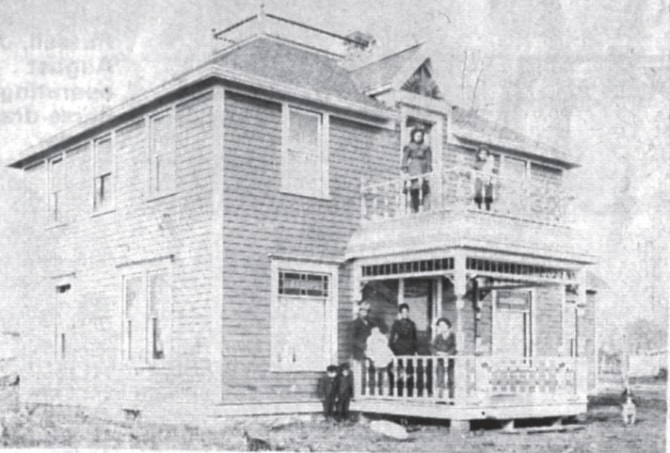The earliest pioneer families who settled in the Ponoka area so many decades ago bravely toiled together to break the lush landscape, faced many challenges while establishing their homesteads and left behind a bright and exciting outlook for our future. Reflections in your Ponoka News is pleased and dedicated to telling the stories of those hardy families, individuals, and true characters who helped to build our long and proud heritage.
The George Irvin Cox family
More commonly known to everyone who got to know him as ‘G.I.’, the outgoing Mr. Cox came to this district from Rapid City, South Dakota in 1899, purchasing the first quarter of land from the Sharphead Reserve. He would later build his first humble log house and barn and named his homestead as the Fairview Stock Farm. The following year, Cox went back to South Dakota to bring back his wife Ann Electra Smith, four young children, Mildred, Mary, James and Floyd, as well as furniture for their small home on the prairies.
Cox also shipped a bunch of horses by rail from his South Dakota ranch and then drove them from the U.S. border to the Village of Ponoka, which was then a part of the North-West Territories. On the way to their new home, the Coxes met the Russell and Wilcocks’ families from Minnesota, with whom they would later become lifelong friends and neighbours. They were later joined in Ponoka by Mrs. Cox’s brother Willard and her father ‘Dad’ Smith, who became a well-liked member of the community and quite often be seen wearing his long blue coat, which was a relic of the Civil War.
They all homesteaded in the district together, and then with his family growing at a rapid pace, Cox completed one of the first and finest homes in the district in 1902 at the N. ½ of section 12 and W ½ of the 7th Sharphead sight 2 miles west and one mile north of Ponoka. The palatial two story home, built of the finest material of the day, featured fancy balconies on the first and second floors as well as the roof, along with over 20 fancy glass windows. One of the first articles published in the local Ponoka Herald newspaper explained that daughter Ruth was the first born in the new Cox house, and then to celebrate the arrival of Gertrude, he raised the price of his surplus land for sale by $1 an acre. All of the Cox children began their education at the one room Sharphead School, which was taught by the future Mrs. Aro Crawford, then later went by horse and buggy to the fancy new Ponoka White School in town.
When Mr. Cox had to return to the United States on business during 1902, he did not want to leave his family alone on the farm, so he bought a boarding house in Ponoka. The family was kept very busy serving meals to the new settlers who stayed with them until their homesteads were completed, but with the town growing at such a rapid pace, they decided to set up a large tent across the road from the boarding house to accommodate all the newcomers. An energetic ‘man of all seasons’ G.I. became very interested and involved in the local sports of basketball, baseball, wrestling, and horse racing, as well as becoming an avid Square Dance caller, and a welcome figure with his family at most community events. They would never miss a gala annual Ponoka Fair, in which he always had horses running.
While always working hard and being involved with his family, Mr. Cox also loved to ‘invent things’, and at one time formed a local company called ‘The Cox Automatic Stock Pump Co’. In those very early years, he was able to develop a working model of the pump, which he used out on the farm, and consisted of a huge steel frame closed in on three sides with a tray attached to the pump. The whole apparatus working on a circular track, with the livestock actually doing the work to activate the pump and fill the tray with the water to quench their thirst. He later invented a disc sharpener, which was able to sharpen the discs while they were working the fields. Likely the most amazing and ingenious product of his genius was a churn which he attached to the baby’s rocker, with Mrs. Cox able to rock the babies and churn the butter at the same time.
Like so many other early pioneers , ‘G.I.’ Cox hired many of the Indians from the Hobbema Reserve to clear his land, and some of these included White Eagle, Blind David, Jimmy Shortneck, Ermineskin and many others. They would arrive at the farm with their families and their tents, and worked until the job was finished. During their visit, a cow was butchered and the meat was shared with the Indians, who also enjoyed the fine baking of Mrs. Ann Cox. Sons James and Floyd both went overseas to serve with the Canadian forces in 1916, where James was killed at Passchendaele, but Floyd returned home safely after the war and married his childhood sweetheart Gladys McKelvie. One of the most memorable events of that era was when Alberta became a province in 1905, and the Cox family, along with many other pioneers from the districts, boarded the train at the Ponoka station and travelled to Edmonton for the colorful Inauguration ceremonies.
After a very active and successful life in this area, George Cox passed away in 1912, after which the family moved to Edmonton, where Ann lived until her death in March 1959. Many of the Cox descendants remained in the area and carried on the strong family tradition, while Fred H. Lee took over the original homestead, as well as renting out more of the original Sharphead Reserve land to Mr. Tom McKelvie.
